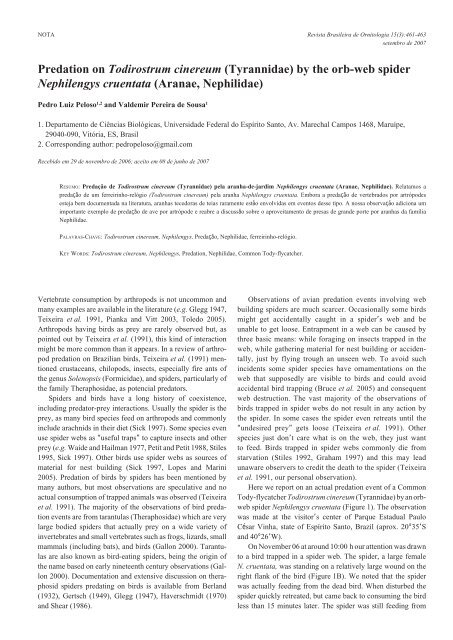Create successful ePaper yourself
Turn your PDF publications into a flip-book with our unique Google optimized e-Paper software.
NOTA<br />
Pre<strong>da</strong>tion on Todirostrum cinereum (Tyranni<strong>da</strong>e) by the orb-web spider<br />
Nephilengys cruentata (Aranae, Nephili<strong>da</strong>e)<br />
Pedro Luiz Peloso 1,2 and Valdemir Pereira de Sousa 1<br />
1. Departamento de Ciências Biológicas, Universi<strong>da</strong>de Federal do Espírito Santo, Av. Marechal Campos 1468, Maruípe,<br />
29040‑090, Vitória, ES, Brasil<br />
2. Corresponding author: pedropeloso@gmail.com<br />
Recebido em 29 de novembro de 2006; aceito em 08 de junho de 2007<br />
Resumo: Pre<strong>da</strong>ção de Todirostrum cinereum (Tyranni<strong>da</strong>e) pela aranha-de-jardim Nephilengys cruentata (Aranae, Nephili<strong>da</strong>e). Relatamos a<br />
pre<strong>da</strong>ção de um ferreirinho‑relógio (Todirostrum cinereum) pela aranha Nephilengys cruentata. Embora a pre<strong>da</strong>ção de vertebrados por artrópodes<br />
esteja bem documenta<strong>da</strong> na literatura, aranhas tecedoras de teias raramente estão envolvi<strong>da</strong>s em eventos desse tipo. A nossa observação adiciona um<br />
importante exemplo de pre<strong>da</strong>ção de ave por artrópode e reabre a discussão sobre o aproveitamento de presas de grande porte por aranhas <strong>da</strong> família<br />
Nephili<strong>da</strong>e.<br />
PalavRas-Chave: Todirostrum cinereum, Nephilengys, Pre<strong>da</strong>ção, Nephili<strong>da</strong>e, ferreirinho‑relógio.<br />
Key WoRds: Todirostrum cinereum, Nephilengys, Pre<strong>da</strong>tion, Nephili<strong>da</strong>e, Common Tody‑flycatcher.<br />
Vertebrate consumption by arthropods is not uncommon and<br />
many examples are available in the literature (e.g. Glegg 1947,<br />
Teixeira et al. 1991, Pianka and Vitt 2003, Toledo 2005).<br />
Arthropods having birds as prey are rarely observed but, as<br />
pointed out by Teixeira et al. (1991), this kind of interaction<br />
might be more common than it appears. In a review of arthro‑<br />
pod pre<strong>da</strong>tion on Brazilian birds, Teixeira et al. (1991) men‑<br />
tioned crustaceans, chilopods, insects, especially fire ants of<br />
the genus Solenopsis (Formici<strong>da</strong>e), and spiders, particularly of<br />
the family Theraphosi<strong>da</strong>e, as potencial pre<strong>da</strong>tors.<br />
Spiders and birds have a long history of coexistence,<br />
including pre<strong>da</strong>tor‑prey interactions. Usually the spider is the<br />
prey, as many bird species feed on arthropods and commonly<br />
include arachnids in their diet (Sick 1997). Some species even<br />
use spider webs as “useful traps” to capture insects and other<br />
prey (e.g. Waide and Hailman 1977, Petit and Petit 1988, Stiles<br />
1995, Sick 1997). Other birds use spider webs as sources of<br />
material for nest building (Sick 1997, Lopes and Marini<br />
2005). Pre<strong>da</strong>tion of birds by spiders has been mentioned by<br />
many authors, but most observations are speculative and no<br />
actual consumption of trapped animals was observed (Teixeira<br />
et al. 1991). The majority of the observations of bird pre<strong>da</strong>‑<br />
tion events are from tarantulas (Theraphosi<strong>da</strong>e) which are very<br />
large bodied spiders that actually prey on a wide variety of<br />
invertebrates and small vertebrates such as frogs, lizards, small<br />
mammals (including bats), and birds (Gallon 2000). Tarantu‑<br />
las are also known as bird‑eating spiders, being the origin of<br />
the name based on early nineteenth century observations (Gal‑<br />
lon 2000). Documentation and extensive discussion on thera‑<br />
phosid spiders pre<strong>da</strong>ting on birds is available from Berland<br />
(1932), Gertsch (1949), Glegg (1947), Haverschmidt (1970)<br />
and Shear (1986).<br />
Revista Brasileira de Ornitologia 15(3):461-463<br />
setembro de 2007<br />
Observations of avian pre<strong>da</strong>tion events involving web<br />
building spiders are much scarcer. Occasionally some birds<br />
might get accidentally caught in a spider’s web and be<br />
unable to get loose. Entrapment in a web can be caused by<br />
three basic means: while foraging on insects trapped in the<br />
web, while gathering material for nest building or acciden‑<br />
tally, just by flying trough an unseen web. To avoid such<br />
incidents some spider species have ornamentations on the<br />
web that supposedly are visible to birds and could avoid<br />
accidental bird trapping (Bruce et al. 2005) and consequent<br />
web destruction. The vast majority of the observations of<br />
birds trapped in spider webs do not result in any action by<br />
the spider. In some cases the spider even retreats until the<br />
“undesired prey” gets loose (Teixeira et al. 1991). Other<br />
species just don’t care what is on the web, they just want<br />
to feed. Birds trapped in spider webs commonly die from<br />
starvation (Stiles 1992, Graham 1997) and this may lead<br />
unaware observers to credit the death to the spider (Teixeira<br />
et al. 1991, our personal observation).<br />
Here we report on an actual pre<strong>da</strong>tion event of a Common<br />
Tody‑flycatcher Todirostrum cinereum (Tyranni<strong>da</strong>e) by an orb‑<br />
web spider Nephilengys cruentata (Figure 1). The observation<br />
was made at the visitor’s center of Parque Estadual Paulo<br />
César Vinha, state of Espírito Santo, Brazil (aprox. 20°35’S<br />
and 40°26’W).<br />
On November 06 at around 10:00 h our attention was drawn<br />
to a bird trapped in a spider web. The spider, a large female<br />
N. cruentata, was standing on a relatively large wound on the<br />
right flank of the bird (Figure 1B). We noted that the spider<br />
was actually feeding from the dead bird. When disturbed the<br />
spider quickly retreated, but came back to consuming the bird<br />
less than 15 minutes later. The spider was still feeding from

















